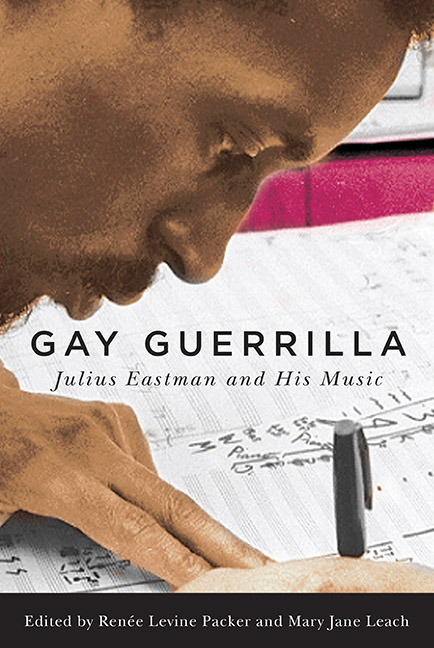Book contents
- Frontmatter
- Contents
- Foreword
- Acknowledgments
- Introduction: Julius Eastman and His Music
- 1 Julius Eastman, A Biography
- 2 Unjust Malaise
- 3 The Julius Eastman Parables
- 4 Julius Eastman and the Conception of “Organic Music”
- 5 Julius Eastman Singing
- 6 An Accidental Musicologist Passes the Torch
- 7 A Flexible Musical Identity: Julius Eastman in New York City, 1976–90
- 8 Evil Nigger: A Piece for Multiple Instruments of the Same Type by Julius Eastman (1979), with Performance Instructions by Joseph Kubera
- 9 A Postminimalist Analysis of Julius Eastman’s Crazy Nigger
- 10 “That Piece Does Not Exist without Julius”: Still Staying on Stay On It
- 11 Connecting the Dots
- 12 Gay Guerrilla: A Minimalist Choralphantasie
- Appendix: Julius Eastman Compositions
- Chronology
- Selected Bibliography
- List of Contributors
- Index
- Eastman Studies in Music
5 - Julius Eastman Singing
Published online by Cambridge University Press: 26 May 2021
- Frontmatter
- Contents
- Foreword
- Acknowledgments
- Introduction: Julius Eastman and His Music
- 1 Julius Eastman, A Biography
- 2 Unjust Malaise
- 3 The Julius Eastman Parables
- 4 Julius Eastman and the Conception of “Organic Music”
- 5 Julius Eastman Singing
- 6 An Accidental Musicologist Passes the Torch
- 7 A Flexible Musical Identity: Julius Eastman in New York City, 1976–90
- 8 Evil Nigger: A Piece for Multiple Instruments of the Same Type by Julius Eastman (1979), with Performance Instructions by Joseph Kubera
- 9 A Postminimalist Analysis of Julius Eastman’s Crazy Nigger
- 10 “That Piece Does Not Exist without Julius”: Still Staying on Stay On It
- 11 Connecting the Dots
- 12 Gay Guerrilla: A Minimalist Choralphantasie
- Appendix: Julius Eastman Compositions
- Chronology
- Selected Bibliography
- List of Contributors
- Index
- Eastman Studies in Music
Summary
The last time I saw Julius Eastman was in London. He was touring in 1974 with the Creative Associates from the State University of New York at Buffalo; they performed in the Queen Elizabeth Hall on the South Bank, and Julius was playing the piano in Morton Feldman's For Frank O’Hara. That was just one of his activities. The ensemble also had a piece by Julius, Stay On It, in their repertory for the tour. Julius seemed fine. He was then thirty-four years old.
Julius's name came up more recently, now many years later, in Essen, Germany, when my colleague at the Folkwang University of the Arts, Patricia Martin, loaned me the multi-CD recording of Julius's music that she had just received. She had played one of the pianos in the famous 1980 performance of his music at Northwestern University in Chicago. To hear the music on the CDs (as well as the spoken defense of his work that is included) is to wonder at his mastery as a composer, singer, and articulate polemicist.
It is sometimes said that certain artists lack discipline. Julius Eastman was often accused of that. Nonetheless, he had enough discipline to develop his abilities to a professional level in several areas: as a pianist, dancer, singer, and composer. Of course, the task of organizing these various talents is always difficult for anyone with such gifts. Being black and gay cannot have made things easier for him, but it may have given him the impetus of anger, fear, and defiance that he needed to pursue such a range of ambitions. I think I should mention, as well, the love he had for so many things, and his humor. If he was provocative, it was because he lived in a prejudiced and repressive time, place, and society, where art can be trivialized, black people cruelly discriminated against, and gays censored, not for what they do, but for who they are.
I am primarily concerned here with Julius's work as a singer. Singing for him, of course, was simply another area where he excelled. He was not a tall person—physically he was rather spindly—but in singing he seemed to spread out.
- Type
- Chapter
- Information
- Gay GuerrillaJulius Eastman and His Music, pp. 100 - 106Publisher: Boydell & BrewerPrint publication year: 2015

